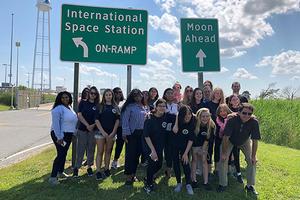Science
Thinsat Program

Space exploration has always been an exciting, yet challenging and costly task. Theories and explorations related to outer space have always been important. Passionate students of all ages at the Twiggs Space Lab, NASA Langley Research Center (LaRC), and Near Space Launch have launched a small satellite program called ThinSat to increase student engagement and interest in Science, Technology, Engineering, and Mathematics (STEM) related fields.
ThinSat is a small satellite with the ability to transmit data from an extreme low earth orbit (ELEO).
The ThinSat program is a three-phase curriculum designed by Twiggs Space Lab. The process includes designing, developing, testing, and operating ThinSats, along with collecting, analyzing, and presenting data acquired with onboard sensors. Phase I is an introductory phase where the participants are introduced to concepts related to satellites and remote sensing. During Phase II, the candidates build and learn more about satellites, engineering, and remote sensing. They also design their experiments for high-altitude weather balloons. Phase III is the most anticipated, where students launch their custom-designed satellites into orbit. It takes a ThinSat five-to-six days to enter ELEO. During this time the students collect, analyze, and interpret the data. A ThinSat utilizes unused space resources and does not create orbital debris. It is a single-layer satellite with one printed circuit board, making it easy to design, build, and assemble.
On April 17, 2019, at 4:46 p.m., sixty ThinSats were launched from Pad 0A of the Mid-Atlantic Regional Spaceport located at NASA Wallops Flight Facility as the secondary load on Northrop Grumman's Antares rocket. As of April 18, 2019, forty-nine of the ThinSats carrying standard and custom payloads were transmitting data (Virginia Space).
American University has recently formed the new Institute for Integrated Space Science and Technology (ISSTI). The goal of ISSTI is to support and grow AU's partnerships with other area institutions involved in space science. It supports nearly twenty externally funded research faculty working on twelve active projects, with total grant funding of more than $7.4 million from NASA, the National Science Foundation, and other sponsors. Presently, ISSTI and AU’s Department of Physics, in partnership with Virginia Space, operator of the Mid-Atlantic Space Port, are working to launch three student-built ThinSats. They are being built in the Design and Build Lab within the Don Myers Technology and Innovation Building. As part of the collaborative, AU students and faculty are working with local schools to expose younger students to the process. Specifically, AU is working with high-school students at H.D. Woodson STEM High School in Washington, DC, and middle school students at St. Elizabeths Catholic School in Rockville, Maryland, to create components for the AU ThinSat. AU students and faculty, along with students and teachers from each of the partner schools, also traveled to the Wallops Flight Facility the past May.
“The program has been a gateway for AU students for getting involved in the Design and Build Lab and getting technical experience. The program also gives students at the college, high school, and middle school levels the opportunity to expand their world views on all the different fields within space science,” Dr. Cyndee Finkel said.
The ThinSat Program is creating amazing opportunities for AU students, staff, and faculty to work together on cutting-edge space science and technology.